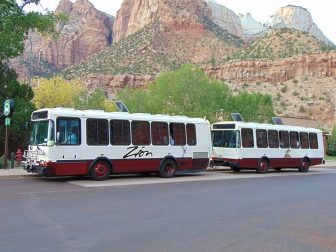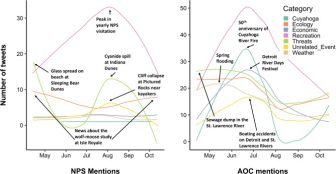
By Daniel Schoenherr
“A little evening run on the Detroit River Walk! Views are beautiful 🤩,” wrote Twitter user @CoachMolly_ in August of 2019.
Within the month, user @NickHayesFilm posted a video of dirty water washing ashore and suggested a different view: “When you go to the detroit river to chill but it smells like gas and looks like gas.”
Great Lakes community members can hold strong, often polarizing, opinions. Now, a University of Wisconsin study published in 2022 in the Journal of Great Lakes Research shows how such views expressed on Twitter can be used to protect the region’s waterways and parks.
“This gives us a way of checking the pulse of community opinion,” said Emily Tyner, the study’s author. She collected and analyzed 40,000 tweets mentioning Great Lakes Areas of Concern and National Park Service locations during the Midwest’s 2019 tourism season.
The study showed that recreation was the most popular topic of discussion, and that users cared more about pollution’s impact on public health than its impact on property values.
Tyner’s team mined Twitter for tweets mentioning Great Lakes Areas of Concern or certain national parks. Each tweet was sorted into categories defined by key terms.
For example, a tweet from user @joeschwarcz reads, “Great bike ride today along the St Lawrence River. The water is now clean enough for the city to have opened a beach. There is also surfing in the rapids. And the Canada geese also enjoyed the day.”

When Zion National Park was threatened by car exhaust, community input played a big role in deciding to implement shuttle buses. Image: An Errant Knight, Creative Commons
That tweet was selected because it contains the term “St Lawrence River”, and the words “clean” and “bike” are key terms for the ecology and recreation categories respectively.
Social media data mining could be a game-changer for state and national parks when officials can see how the public reacts to policy changes, Tyner said. “It’s really exciting to see the response to these events real-time.”
One event that stood out in online discussions came from an ongoing predator-prey study at Isle Royale National Park. As details came out surrounding the study in April, it sparked debate on whether wolves should be reintroduced into the park. Ecology was the most tweeted-about feature for Isle Royale. That’s unlike all other Great Lakes National Park Service locations where recreation terms were tweeted most.
Community input on environmental decisions is mostly collected through phone or mail-in surveys, Tyner said. Doing surveys well costs a lot of time and money. And people outside of the survey’s range or those who choose not to respond can’t be accounted for.
Twitter data mining is cheaper and dramatically expands the sample size. It can be especially helpful in passing legislation, Tyner said. “It’s important to know you have community support.”
But there are downsides to using Twitter to collect community input, Tyner said.

Boating accidents in the Detroit River and a cliff collapse at Pictured Rocks were unexpected topics of discussion surrounding Great Lakes Areas of Concern on Twitter in 2019. Image: Emily Tyner
People with strong opinions tend to hold a large presence on Twitter. This can have benefits, Tyner said. “You’re capturing the most enthusiastic people. … It’s fine, it’s people’s emotion.”
While Twitter has a greater reach than traditional surveys, it still doesn’t represent the entire region’s population, Tyner said. Combining data from social media with surveys would give researchers the benefits of both methods.
“We need to ask ourselves, ‘Who isn’t represented?’,” said Elizabeth Perry, assistant professor of Protected Areas & Natural Resources Recreation Management at Michigan State University. When surveys are only given to park visitors, people who had barriers to access or didn’t know about the survey don’t hear about it.
Community input is important when parks are making difficult decisions, Perry said. “We find ourselves in circumstances where we need to pick options that will both be approved by the public and be in the park’s best interest.”
Perry is working on a climate action plan with the Huron Metroparks system in Michigan. The plan will be shaped by feedback from members and visitors, collected from both surveys and social media.
It’s a new way of expressing an old value: “Meaningfully including people in these [decision-making] areas is an expression of our democratic ideals,” Perry said.